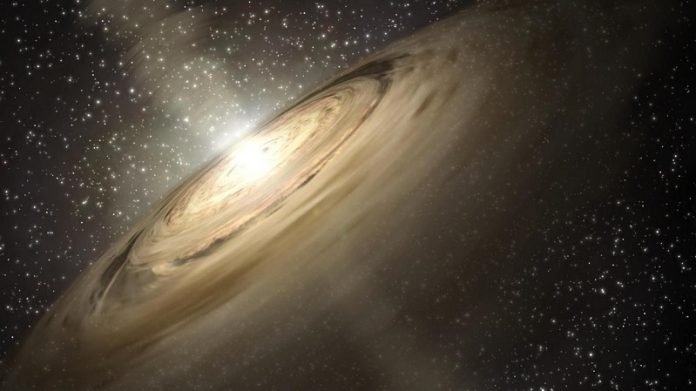
A new analysis of ceramic chips embedded in meteorites suggests the formation of our solar system was not as quiet and orderly as we once thought.
The new study builds evidence that the baby solar system likely witnessed wild temperature swings and changing conditions.
That contradicts the decades-old theory that the solar system had gradually and steadily cooled following the formation of the sun.
The study finds its answers in gifts from outer space.
Because rocks on Earth are constantly pulled under tectonic plates, melted, and reformed, they don’t offer much evidence for what our solar system looked like four and half billion years ago. Instead, scientists look to meteorites.
“These meteorites are basically aggregates of the dust that was in the solar nebula when the planets formed,” says coauthor Nicolas Dauphas, a professor in the geophysical sciences department at the University of Chicago.
“They are a snapshot of what was going on at the particular time period.”
A particular kind of meteorite called a carbonaceous chondrite often comes studded with bits of ceramic material, like chocolate chips in a cookie.
These chips are even older than their cookies; they are thought to be witness to the first 100,000 years of our solar system.
For decades, scientists have analyzed meteorites to try to understand the conditions of the early solar system, which can offer clues as to how the planets formed.
The prevailing view was that the sun had cooled gently and steadily, and objects such as the ceramic chips were formed out of solar gas that had quietly condensed.
But some other recent findings have caused scientists to question this view, and new technology means we are now capable of much more rigorous studies. Armed with new techniques, graduate student Justin Hu sought to analyze the makeup of the ceramic chips with extreme precision.
Hu and Dauphas wanted to measure the amounts of different isotopes in the chips, which can tell you about the conditions in the gas as the chips formed.
Using complex equipment in Dauphas’ Origins Lab, including a one-of-a-kind patented purification system that the team developed, Hu measured the isotopes for eight different elements inside the chips.
“They did not have the signature we were expecting,” says Hu, who is the first author of the study. “The results indicated that temperatures these ceramic inclusions encountered as they formed would have been over 1,600 Kelvin—or about 2,400 degrees Fahrenheit—over tens to hundreds of years.”
This picture indicates a young star that was flaring and fluctuating over a long time period, affecting everything around it.
Scientists had observed such extreme flares around young stars in other solar systems, but they weren’t sure whether this happened in our own system.
“Understanding these conditions is very important because it sets the stage for the formation of the planets,” Dauphas says. “They can tell you about the processes that shaped the composition of solar system planets—for example, why do Earth and Mars have different makeups?”
“This isn’t the first evidence that the early stages of our sun were violent years,” says coauthor Andrew M. Davis, “but there’s a richness to these findings that allows us to say more about the timescale over which this occurred—which is many, many days.”
Davis was among a group of scientists who conducted some of the first such studies on similar meteorites back in the 1970s. “Justin has now proved the primary process was evaporation, not condensation,” he says.
“It’s very satisfying to see our ideas from a long time ago that were partially right, but also to see them proved wrong in a really elegant and quantitative way.”
Th research appears in Science Advances.



